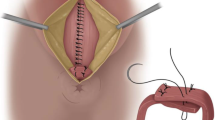Abstract
PURPOSE: Fecal diversion for sphincter repair is controversial. This randomized trial assessed whether fecal diversion would improve primary wound healing and functional outcome after sphincter repair. METHODS: Thirty-three patients with fecal incontinence requiring sphincter repair were recruited, but only 27 agreed to be randomly assigned to a defunctioning stoma (n=13) or no stoma (n=14). Patients were assessed by the Cleveland Clinic Incontinence Score (0–20) and anal physiology; the mean follow-up was 34 (range, 16–47) months. RESULTS: Incontinence score improved significantly in both groups (stoma, 13.5–7.8;P = 0.0072; no stoma, 14–9.6;P=0.0470): No difference was found between the two groups. Maximum resting pressure and maximum squeeze pressure increased significantly only in the no-stoma group (maximum resting pressure, 52.4–71.3 cm H2O; maximum squeeze pressure, 87.3–100.7 cm H2O;P<0.0001). There was no significant difference in functional outcome (stoma, 7.8; no stoma, 9.6;P=0.4567) or the number with complications of sphincter repair (stoma, 5; no stoma, 3;P=0.4197). However, stoma-related complications occurred in 7 of 13 patients having a stoma (parastomal hernia, 2; prolapsed stoma, 1; incisional hernia at the stoma site requiring repair, 5; and wound infection at the closure site, 1). CONCLUSION: Fecal diversion in sphincter repair is unnecessary, because it gives no benefit in terms of wound healing or functional outcome, and it is a source of morbidity.
Similar content being viewed by others
References
Johanson JF, Lafferty J. Epidemiology of fecal incontinence: the silent affliction. Am J Gastroenterol 1996;91:33–6.
Young CJ, Mathur MN, Eyers AA, Solomon MJ. Successful overlapping anal sphincter repair: relationship to patient age, neuropathy and colostomy formation. Dis Colon Rectum 1998;41:344–9.
Sitzler PJ, Thomson JP. Overlap repair of damaged anal sphincter: a single surgeon's series. Dis Colon Rectum 1996;39:1356–60.
Engel AF, Kamm MA, Sultan AH, Bartram CI, Nicholls RJ. Anterior anal sphincter repair in patients with obstetric trauma. Br J Surg 1994;81:1231–4.
Yoshioka K, Keighley MR. Sphincter repair for fecal incontinence. Dis Colon Rectum 1989;32:39–42.
Oliveira L, Pfeifer J, Wexner SD. Physiological and clinical outcome of anterior sphincteroplasty. Br J Surg 1996;83:502–5.
Briel JW, de Boer LM, Hop WC, Schouten WR. Clinical outcome of anterior overlapping external anal sphincter repair with internal anal sphincter imbrication. Dis Colon Rectum 1998;41:209–14.
Author information
Authors and Affiliations
About this article
Cite this article
Hasegawa, H., Yoshioka, K. & Keighley, M.R.B. Randomized trial of fecal diversion for sphincter repair. Dis Colon Rectum 43, 961–964 (2000). https://doi.org/10.1007/BF02237359
Issue Date:
DOI: https://doi.org/10.1007/BF02237359




